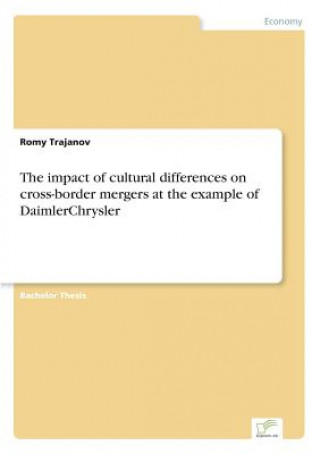
Dostava
Savjetnik za kupnju





Proizvod vam ne odgovara? Nema veze! Možete nam vratiti unutar 30 dana
 Poklon bon
u bilo kojoj vrijednosti
Poklon bon
u bilo kojoj vrijednosti
S poklon bonom ne možete pogriješiti. Za poklon bon primatelj može odabrati bilo što iz naše ponude.
impact of cultural differences on cross-border mergers at the example of DaimlerChrysler
 Engleski
Engleski
 289 b
289 b
30 dana za povrat kupljenih proizvoda
Moglo bi vas zanimati i


Inhaltsangabe:Abstract: In the last decade many companies on a global basis are żgoing internationalż in order to become global players. The opening of global markets (e.g. the establishment of the Single European Market and the ratification of the Maastricht Treaty in 1992) was a key driver for international mergers and acquisitions. Companies form international mergers and acquisitions to achieve the competitive position of global advantage and local responsiveness as well as to grow rapidly. Mergers create synergies for all involved companies as various tangible and intangible assets will be combined whose value is greater than the sum of their individual worth. Additional factors of production offering competitive advantage can be found. Employees play an essential role for the success of merging companies, therefore it is crucial already to deal with cultural aspects as a component of the due diligence process. This creates an understanding of different national and organizational cultures for all involved cross-border merging companies. The national culture is an integral part of the overall corporate culture of the firm, which is applicable for all merging partners. The merger of DaimlerChrysler in 1998 which created one of the biggest car companies is used as an example in this study to underline cultural implications within the merging process of global players. Cultural difficulties occurred between the more żeasy-goingż and more flexible style of Chrysler and the well structured and bureaucratic style of Daimler-Benz. This was the basis of different working styles, decision making and communication processes within the company. This incompatibility of the two different cultural aspects was realized too late and became very difficult to be overcome. That is why at the end it was no żmerger of equalsż but one company dominating over the other. The complexity of the DaimlerChrysler merger shows the different aspects of cultural difference awareness. The reader of this study will get a deeper insight into the issues of culture and its importance to be considered in cross-border merger processes. In this context further different national culture models will be analysed as well as the cultural implementation into organisations in general. Furthermore after presenting the merger process of DaimlerChrysler and its reasons, failures in management and cultural implementation by both companies will be discovered which caused the cultural clash, before and after the merger. The DaimlerChrysler merger could serve as an example for future mergers in any industry concerning the avoidance of underestimating the cultural issues. The dissertation will include research, analysis and investigation of the generic subject of cross-border mergers and appropriate cultural issues. The theoretical part will have three different sub objectives. Firstly, to give the reader an overview about the types, reasons and synergies of mergers as mergers play an important role for many companies in order to survive on the highly competitive marketplace. Secondly, a consideration of the definition of culture and a comparison and summary of the different national cultures of the USA and Germany based on different famous cultural dimension models, e.g. from Geert Hofstede, Fons Trompenaars and Edward T. Hall and their comparison afterwards. Thirdly, a consideration and an analysis of corporate culture differences and its cross-cultural integration process by the management. This theoretical part will be followed by an illustration of the exemplary experience made by DaimlerChrysler during its cross-border merger. The reasons for this merger will be identified as well as synergies resulting from this merger as a potential source of value creation. Furthermore there will be an analysis of success and failure factors as well as a c...
Informacije o knjizi
 Engleski
Engleski




 Kako kupovati
Kako kupovati





















